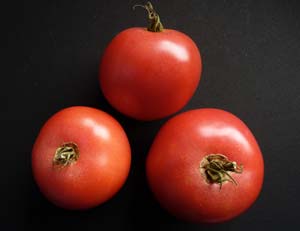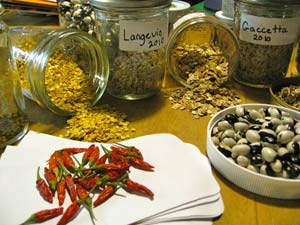  |
| ‘Chateau Rose’ tomatoes. English photo |
 |
| A display of seed saving in the Exhibition Hall at the Common Ground Country Fair. Amy LeBlanc photo |
By Jean English
Many garden seeds can be collected now and stored for planting in spring. Echinacea seeds are drying on their seed heads – at least those that the goldfinches aren’t eating. ‘Jimmy Nardello’ sweet peppers are long and red; it’s time to eat the flesh and save the scraped-away seeds. ‘Chateau Rose’ tomato seeds are ripe for the taking (i.e., for the fermenting).
How long can seeds last in storage? Tales exist of lotus seeds from Japan and of barley seeds coming from King Tut’s tomb germinating after thousands of years, but plant physiologists say those are likely just tales – that the artifacts found with the seeds were dated but the seeds weren’t, and/or that the found seeds weren’t viable (capable of germinating).
Most of us aren’t worried about saving our seed for thousands of years – which is good, because most garden seeds are viable for about one to six years. Under good storage conditions (cool conditions and uniformly low humidity), onions are on the low end of the longevity (shortevity?) spectrum, lasting about a year, while cucumber and tomato seeds may last five to 10 years (see https://www.fedcoseeds.com/seeds/seed_saving.htm).
To harvest seeds from open-pollinated, nonhybrid tomatoes, I cut the fruits into quarters or more (depending on the size of the fruit) and put the cut pieces in a glass of water. After four or five days, the viable seeds have fallen to the bottom of the glass and the pulp and nonviable seeds have floated to the top. This fermentation is a slightly messy process, much loved by fruit flies, but worth the minor effort.
On day five or when numerous seeds have settled to the bottom of the glass, just decant off the top portion of pulp and water (into the compost pile) and add clean water to the glass. Let the seeds settle again and pour off most of the water. Repeat this process two or three times until the water runs clear. Then pour the remaining water and seeds through a tea strainer, plop the seeds from the strainer onto a few sheets of newspaper and spread them out to dry.
Once seeds are dry, wait for a day when the humidity is low and then put the seeds in small Ziploc bags, seal them tightly, and place them in a cool, dry place. The bag should seal out most moisture.
You can also store seeds in paper envelopes placed in a Mason jar on a dry day, perhaps with some desiccant such as silica packs or a packet of dried milk in the bottom of the jar to absorb moisture. Seal the jar tightly and place it in a cool cellar or refrigerator and wait for spring.
If you save more seeds than you need, why not share them at the Common Ground Country Fair? The Seed Swap in the Exhibition Hall at the Fair will be open on Saturday from 11 a.m. to 5 p.m. and on Sunday 9 a.m. to noon. Bring your seed-saving questions, too!
